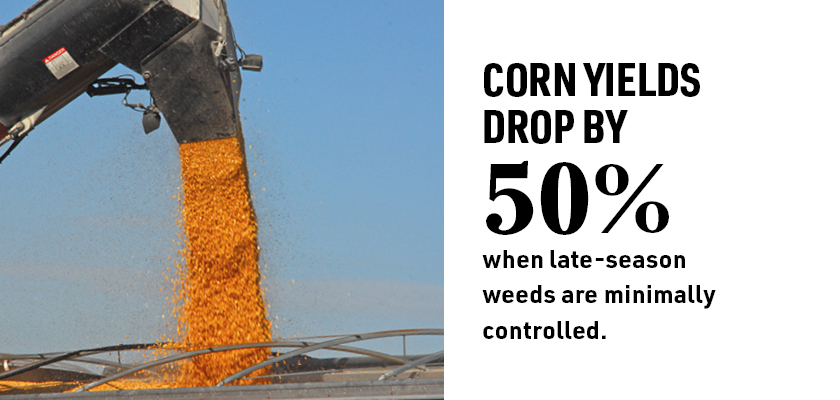The Double Whammy Of Weeds And Stressful Weather

Weeds combined with stressful weather whack your corn yields
Earning a 93% on a test will earn you an “A” in class, but it’s not near good enough for weed control in your fields, especially if your corn is under stress.
“It doesn’t take many weeds to have a major impact on corn yields,” says Marty Williams, ecologist with USDA’s Agricultural Research Service. “Weeds are not getting easier to manage, and with extreme weather, incomplete weed control will actually exacerbate corn yield loss.”
WEATHER AND WEEDS
Wet springs that delay planting and hot, dry summers stress corn. They also provide a welcoming environment for scrappy weeds. This combination can prove a heavy drag on yields. In fact, late-season control of weeds such as waterhemp can be the most important factor affecting corn yield — bigger than any management practice or weather-related factor, Williams says.
To arrive at that conclusion, a University of Illinois research team including Williams and Aaron Hager, University of Illinois Extension weed scientist, analyzed 27 years of herbicide evaluation trials representing more than 200 unique weather environments throughout Illinois.
Machine-learning algorithms helped the researchers make sense of the complex dataset. They looked at:
- Crop management considerations, including planting date, hybrid choice and planting density.
- Percent weed control for multiple weed species.
- Weather data at key growth stages throughout the corn life cycle.
- Yield.
The University of Illinois analysis showed an average of 50% loss when late-season weeds were minimally controlled. Even with relatively robust late-season weed control (up to 93%), weeds exacerbated crop losses in hot or dry conditions.

“The combination of less-than-complete weed control and these weather events is where we see crop losses much larger than from poor weather alone,” Williams says. “Achieving 94% weed control late into the season is a high bar. I’d be surprised if many fields hit that mark for weed control on a regular basis.”
The timing of the weather extremes is also a determining factor in yield. The study found if a period of drought takes hold just after pre-emergence herbicides are applied, the chemistry won’t be as effective and young plants then have to battle early weeds.
Additionally, Williams says, the period before and during silking was most sensitive to the combination of poor weed control and drought or excessive heat.

MOVE THE GOALPOSTS
As weather plays a role in weed control, Williams and Hager say now is the time to come up with new ways to manage weeds. They hope their research sends that message to farmers and companies working to come up with other solutions for farmers.
“It’s safe to say weeds are going to adapt, whether it’s to climate changes or how we’re trying to manage them,” Hager says. “They will figure out a way through the evolutionary process to survive and reproduce.”
As weeds adapt to a changing climate, weed scientists stress the importance of a multifaceted approach to controlling weeds. From rotating chemistries to introducing new sprayer technology to cover crops, the weed-control game must become stronger.
“It’s time to move the goalposts and think about what else we can do to ensure by the end of the growing season, there’s no weed seed that's added back into the soil seedbank,” Hager says. That’s the win.”








